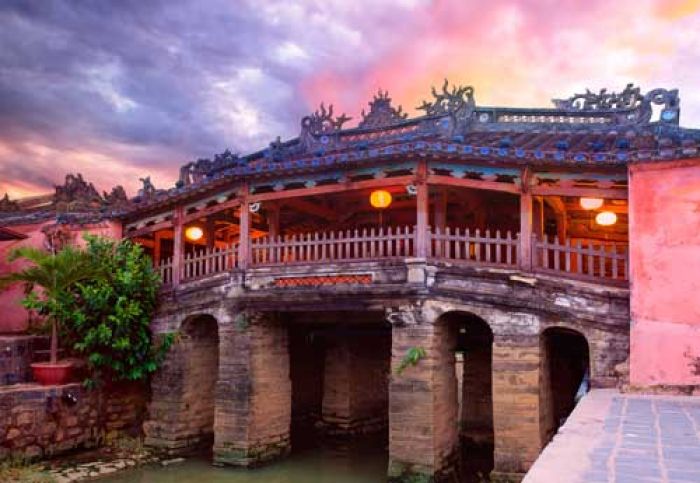Activities
Bridge Hoi An - part of an enchanting excursion

The Bridge Hoi An, or Japanese Bridge (Chùa Cầu), is located right in the heart of Ancient Town Hoi An.
This enchanting excursion will take you to visit the famous Hoi An Old Quarter. This is an exceptionally well-preserved example of a Southeast Asian trading port dating from the 15th to the 19th century. The buildings and street plan reflect the influences, both indigenous and foreign, that have combined to produce this unique heritage site.
-Must-See Landmark: Japanese Bridge Hoi An
There is a lot of historic value and architectural brilliance in this city, but the Japanese Bridge serves as one of its most representative symbols. In addition to being named after bridges, it was built in the late 16th century across the quiet waters of the Thu Bồn River. This bridge also functions as a temple. When constructing it, they combined Vietnamese culture with Chinese and Japanese styles, which made for many large ports like Bridge Hoi An in Southeast Asia at that time.
The origin story behind what we now call the Bridge Hoi An dates back to 1593, when people living here wanted to connect their quarter with another Chinese district just across from them, separated by a river. They put it there because there was a myth about a sea monster called Mamazu that causes earthquakes among other disasters so they hoped those things would stop happening, thereby showing deeper cultural meanings behind construction acts as a protector against natural calamities.
Once you have entered through gates protected by pairs of monkeys and dogs on either side of Bridge Hoi An, you will find various statues representing different years when each part was made or finished decoration design inside this beautiful structure. This magnificent bridge has roofs that are gracefully arched and covered with beautifully carved Eastern motifs while using yin-yang tiles on the top part of the roof and porcelain bowls placed at the end tile strategically. All these show how much love went into creating such work using traditional techniques from Japan.
Tour among Hoi An’s narrow streets lined with traditional houses and its most significant monuments such as the Japanese bridge, built by Japanese craftsmen who were part of a larger community of Japanese merchants active in Hoi An at that time and envisioned transforming the town into a great trading centre.
Originally built more than four centuries ago as a means to cross over water bodies between two sections within town limits, apart from its function, the bridge also shows that there is also a Tran Vo Bac De (Joy Prosperity) temple located here where peace can be found in mind and heart so place meets religion meets culture at Bridge Hoi An, reflecting on life values cherished by everyone living within the area.
Bridge Hoi An has undergone several restorations aimed at keeping historical value while preserving beauty; some were done in 1986 and 1996, which reflect across time and civilizations not only physical connections between the same town parts but also different places.
Nowadays, open to pedestrians as well as vehicles, one should pay a visit whenever they find themselves in Hoi An. Especially during the evening, when lit-up lights from houses nearby create an enchanting atmosphere around Bridge Hoi An, making it a perfect spot for photoshoots. In order to get through, you need to buy a ticket that allows entry into other old town sites too so it should form part of any tourists’ itinerary who want to explore these areas.
Bridge Hoi An connects two parts of an old town. It has proved its strength through many tests over the years. Also, it acts as a connection between the past and present for people to visit and learn more about other historical architectural wonders of this city too. No place reflects on history in Vietnam like this one does—sojourning travelers from every nook are welcomed to witness such an antique jewel among cultural gems throughout Asia that must not be overlooked during trips around the continent.
Please contact DMC Vietnam for further information. They will help with lodging, dining, planning events, and getting you and your clients around.
Additionally, use the website of Visit Vietnam. They have a great page about Bridge Hoi An.
Search for a DMC
Our DMCs can assist with accommodation, (gala) dinners, meeting rooms, transport, team building and other options you need for your event
More Activities
-
Dubai’s CSR Food Aid Initiative
-
A building in the world that houses a whole town - guess where
-
Rajasthan Desert Safari
-
Safari in Niokolo Koba National Park
-
Drive a Classic Mini Through London
-
Jet Boating in New Zealand
-
Dune Bashing in Oman
-
Sailing the Nile in Uganda
-
Drumming Up Fun in Rwanda
-
Why Merida Should Top Your List
-
Big 5 Safari Mozambique
-
Game Drive in Chobe
-
Medieval Feasting in Lithuania
-
Wildlife Conservation in Action: Visiting Lion-Proof Bomas in Kenya
-
Afternoon Tea in London the Royal Way
-
Climb Kilimanjaro for Lion Conservation
-
Discover the Hidden Gems of Bucharest
-
Organic Farming for Climate Action in Fujairah
-
Greener Beach for a Greener Company Event


